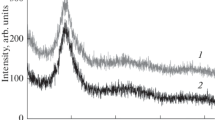Abstract
Electrical conductivity/resistivity of elemental fcc metals, such as Al and Cu, has been investigated intensively for decades, both theoretically and experimentally. Since these metals are of great practical importance for electrical wiring, reducing their resistivity even by a few percent may have very strong impact on their application effectiveness. In this paper, we report on electrical resistivity measurements in Al single crystals grown by the Bridgman method. We found that their resistivity at room temperature decreases by 11.5% upon heat treatment in a boron environment at 600 °C, i.e., well below the melting temperature of Al (Tm = 660 °C). The residual resistivity indeed reaches its lower limit dictated by electron–phonon interaction at room temperature. We explain this effect by the boron-induced formation of distorted regions at the surface of the Al crystals. These regions are 30–50 μm in size and comprise finer grains with an average size of 5 μm, separated by low-angle grain boundaries. Resistivity reduction is mainly due to the getter effect, i.e., the removal of the impurity atoms from the crystal bulk by the outward diffusion to the distorted surface regions.















Similar content being viewed by others
References
Fickett FR (1971) Aluminum. A review of resistive mechanisms in aluminum. Cryogenics 10:349–366
Lifshitz BG, Kraposhin VS, Linezky YL (1980) Physical properties of metals and alloys. Metallurgia Press, Moscow, p 319
Rositter PL (2003) The electrical resistivity of metals and alloys. Cambridge University Press, Cambridge
Valiev RZ, Murashkin MYu, Sabirov I (2014) A nanostructural design to produce high-strength Al alloys with enhanced electrical conductivity. Scripta Mater 76:13–16
Ziman JM (1979) Principles of the theory of solids. Cambridge University Press, Cambridge
Gall D (2016) Electron mean free path in elemental metals. J Appl Phys 119:085101
Crystal Growth Technology (2011) From fundamentals and simulation to large-scale production. In: Scheel HJ, Capper P (eds) Wiley-VCH Verlag, p 497
Pouraliakbar H, Jandaghi MR, Khalaj G (2017) Constrained groove pressing and subsequent annealing of Al–Mn–Si alloy: microstructure evolutions, crystallographic transformations, mechanical properties, electrical conductivity and corrosion resistance. Mater Des 124:34–46
Jandaghi MR, Pouraliakbar H (2018) Elucidating the microscopic origin of electrochemical corrosion and electrical conductivity by lattice response to severe plastic deformation in Al–Mn–Si alloy. Mater Res Bull 108:195–206
Hashimoto E, Ueda Y, Kino T (1995) Purification of ultra-high purity aluminium. J de Physique IV 5:153–157
Ueda Y, Hashimoto E, Tamura H, Kino T (1995) Anisotropy of electrical resistivity in high purity aluminium single crystals. J de Physique IV 5:287–292
Alamdari HD, Dube D, Tessier P (2013) Behavior of boron in molten aluminum and its grain refinement mechanism. Metal Mater Trans A 44:388–394
Marcantonio JA, Mondolfo LF (1971) Grain refinement in aluminum alloyed with titanium and boron. Metal Trans 2:465–471
Molodov DA, Ivanov VA, Gottstein G (2007) Low angle tilt boundary migration coupled to shear deformation. Acta Mater 55:1843–1848
Faran F, Gotman I, Gutmanas EY (2000) Experimental study of the reaction zone at boron nitride ceramic–Ti metal interface. Mater Sci Eng A 288:66–74
David M, Connétable D (2017) Diffusion of interstitials in metallic systems, illustration of a complex study case: aluminum. J Phys Condens Matter 29:1361–1368
de Boor J, Stiewe C, Ziolkowski P, Dasgupta T, Karpinski G, Lenz E, Edler F, Mueller E (2013) High-temperature measurement of Seebeck coefficient and electrical conductivity. J Electron Mater 42:1711–1718
Graff A, Amouyal Y (2016) Effects of lattice defects and niobium doping on thermoelectric properties of calcium manganate compounds for energy harvesting applications. J Electron Mater 45:1508–1516
Sheskin A, Schwarz T, Yu Y, Zhang S, Abdellaoui L, Gault B, Cojocaru- Mirédin O, Scheu C, Raabe D, Wuttig M, Amouyal Y (2018) Tailoring thermoelectric transport properties of Ag-alloyed PbTe: effects of microstructure evolution. ACS Appl Mater Interfaces 10:38994–39001
Koresh I, Amouyal Y (2017) J Eur Ceram Soc 37:3541–3550
Hughes DA, Hansen N (2000) Microstructure and strength of nickel at large strains. Acta Mater 48:2985–3004
Cockayne D, Ray I, Whelan M (1969) Investigations of dislocation strain fields using weak beams. Phil Mag 20:1265–1270
Zolotoyabko E (2014) Basic concepts of X-ray diffraction. Wiley-VCH, Weinheim
Simmons RO, Balluffi RW (1960) Measurements of equilibrium vacancy concentrations in aluminum. Phys Rev 117:52–61
Duschanek H, Rogl P (1994) The AI-B (aluminum-boron) system. J Phase Equilib 15:542–552
Wright SI, Novell MM, Field DP (2011) A review of strain analysis using electron backscatter diffraction. Microsc Microanal 17:316–329
Seidel TE, Meek RL, Cullis AG (1975) Direct comparison of ion-damage gettering and phosphorus-diffusion gettering of Au in Si. J Appl Phys 46:600–609
Kang JS, Schroder DK (1989) Gettering in silicon. J Appl Phys 65:2974–2985
Acknowledgements
Prof. R. Lapovok acknowledges the Marie Curie Fellowship within the EU Framework Program for Research and Innovation ‘HORIZON 2020’ (Grant - 742098). We thank Dr. T. Kravchuk for her help with TOF–SIMS measurements.
Author information
Authors and Affiliations
Corresponding author
Additional information
Publisher's Note
Springer Nature remains neutral with regard to jurisdictional claims in published maps and institutional affiliations.
Rights and permissions
About this article
Cite this article
Lapovok, R., Amouyal, Y., Qi, Y. et al. Enhancement of electrical conductivity in aluminum single crystals by boron treatment in solid state. J Mater Sci 55, 2564–2577 (2020). https://doi.org/10.1007/s10853-019-04070-x
Received:
Accepted:
Published:
Issue Date:
DOI: https://doi.org/10.1007/s10853-019-04070-x




